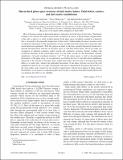Hierarchical phase space structure of dark matter haloes: Tidal debris, caustics, and dark matter annihilation
Author(s)
Afshordi, Niayesh; Mohayaee, Roya; Bertschinger, Edmund
DownloadAfshordi-2009-Hierarchical phase s.pdf (1.604Mb)
PUBLISHER_POLICY
Publisher Policy
Article is made available in accordance with the publisher's policy and may be subject to US copyright law. Please refer to the publisher's site for terms of use.
Terms of use
Metadata
Show full item recordAbstract
Most of the mass content of dark matter haloes is expected to be in the form of tidal debris. The density
of debris is not constant, but rather can grow due to formation of caustics at the apocenters and pericenters
of the orbit, or decay as a result of phase mixing. In the phase space, the debris assemble in a hierarchy
that is truncated by the primordial temperature of dark matter. Understanding this phase structure can be
of significant importance for the interpretation of many astrophysical observations and, in particular, dark
matter detection experiments. With this purpose in mind, we develop a general theoretical framework to
describe the hierarchical structure of the phase space of cold dark matter haloes. We do not make any
assumption of spherical symmetry and/or smooth and continuous accretion. Instead, working with
correlation functions in the action-angle space, we can fully account for the hierarchical structure
(predicting a two-point correlation function ∝ΔJ[superscript -1.6] in the action space), as well as the primordial
discreteness of the phase space. As an application, we estimate the boost to the dark matter annihilation
signal due to the structure of the phase space within virial radius: the boost due to the hierarchical tidal
debris is of order unity, whereas the primordial discreteness of the phase structure can boost the total
annihilation signal by up to an order of magnitude. The latter is dominated by the regions beyond 20% of
the virial radius, and is largest for the recently formed haloes with the least degree of phase mixing.
Nevertheless, as we argue in a companion paper, the boost due to small gravitationally-bound substructure
can dominate this effect at low redshifts.
Date issued
2009-04Department
Massachusetts Institute of Technology. Department of Physics; MIT Kavli Institute for Astrophysics and Space ResearchJournal
Physical Review D
Publisher
American Physical Society
Citation
Afshordi, Niayesh, Roya Mohayaee, and Edmund Bertschinger. “Hierarchical phase space structure of dark matter haloes: Tidal debris, caustics, and dark matter annihilation.” Physical Review D 79.8 (2009): 083526. © 2009 The American Physical Society
Version: Final published version
ISSN
1550-2368
1550-7998